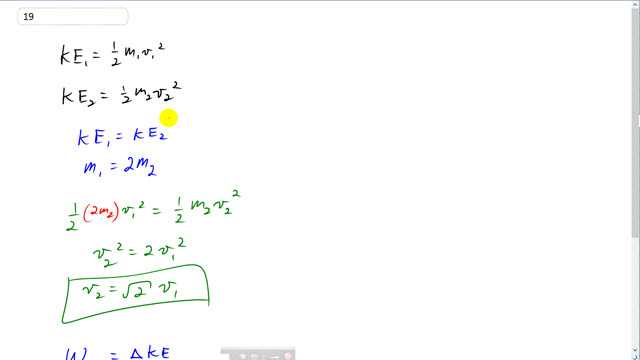
Two bullets are fired at the same time with the same kinetic energy. If one bullet has twice the mass of the other, which has the greater speed and by what factor? Which can do the most work?
- they both do the same work

In order to watch this solution you need to have a subscription.
This is Giancoli Answers with Mr. Dychko. The kinetic energy of the first bullet is one-half times the first bullet's mass times first bullet's speed squared. And the second bullet is one-half m 2 v 2 squared. We are told that the kinetic energy of each bullet is the same and that bullet one has a mass of two times of bullet two. So let's rewrite the kinetic energy of bullet one with a substitution for m 1 as 2 m 2. And so we have, one-half 2 m 2 times v 1 squared equals kinetic energy two, one-half m 2 v 2 squared. And the m 2's cancel and this 2 and this one-half cancel. So we have v 2 squared equals 2 times v 1 squared. Then a couple of things; I switched the sides around and then multiplied both sides by 2. That means v 2 is square root 2 times v 1. So v 2, the particle with the smaller mass, has a speed that's root 2 times greater than v 1. And they can both do the same amount of work because the net work done by something is its change in kinetic energy and we are told that they both have the same kinetic energy; so they'll both have the same kinetic energy when they come to rest, when they collide with something to do work, and so they will both do the same amount of work.
If you multiply both sides by two, why does that not effect the 2 on the 2m2 making it 4m2 resulting in v2= the square of 4v1?
Hi acw, both sides are multiplied by a half (shown in green), so multiplying both sides by 2 results just gets rid of the factor1/2. To put it in different words: the factor 2 cancels with the factor 1/2 that's already present on both sides. We're left with the following, which is a line that I skipped in the video: . The common factor on both sides cancels, and, after switching the sides around to have on the left, we have the line in the video .
Hope this helps,
Shaun